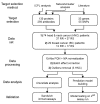Molecular Profiling for Predictors of Radiosensitivity in Patients with Breast or Head-and-Neck Cancer
- PMID: 32235817
- PMCID: PMC7140105
- DOI: 10.3390/cancers12030753
Molecular Profiling for Predictors of Radiosensitivity in Patients with Breast or Head-and-Neck Cancer
Abstract
Nearly half of all cancers are treated with radiotherapy alone or in combination with other treatments, where damage to normal tissues is a limiting factor for the treatment. Radiotherapy-induced adverse health effects, mostly of importance for cancer patients with long-term survival, may appear during or long time after finishing radiotherapy and depend on the patient's radiosensitivity. Currently, there is no assay available that can reliably predict the individual's response to radiotherapy. We profiled two study sets from breast (n = 29) and head-and-neck cancer patients (n = 74) that included radiosensitive patients and matched radioresistant controls.. We studied 55 single nucleotide polymorphisms (SNPs) in 33 genes by DNA genotyping and 130 circulating proteins by affinity-based plasma proteomics. In both study sets, we discovered several plasma proteins with the predictive power to find radiosensitive patients (adjusted p < 0.05) and validated the two most predictive proteins (THPO and STIM1) by sandwich immunoassays. By integrating genotypic and proteomic data into an analysis model, it was found that the proteins CHIT1, PDGFB, PNKD, RP2, SERPINC1, SLC4A, STIM1, and THPO, as well as the VEGFA gene variant rs69947, predicted radiosensitivity of our breast cancer (AUC = 0.76) and head-and-neck cancer (AUC = 0.89) patients. In conclusion, circulating proteins and a SNP variant of VEGFA suggest that processes such as vascular growth capacity, immune response, DNA repair and oxidative stress/hypoxia may be involved in an individual's risk of experiencing radiation-induced toxicity.
Keywords: biomarker; breast cancer; head-and-neck cancer; ionizing radiation; mandibular osteoradionecrosis; personalized radiotherapy; plasma proteins; prediction; radiosensitivity; radiotherapy; radiotherapy side effects; skin reaction.
Conflict of interest statement
The authors declare no conflict of interest. The funders had no role in the design of the study; in the collection, analyses, or interpretation of data; in the writing of the manuscript, or in the decision to publish the results.
Figures





References
-
- West K., Schneider M., Wright C., Beldham-Collins R., Coburn N., Tiver K., Gebski V., Stuart K.E. Radiation-induced oesophagitis in breast cancer: Factors influencing onset and severity for patients receiving supraclavicular nodal irradiation. J. Med. Imaging Radiat. Oncol. 2019;64:113–119. doi: 10.1111/1754-9485.12943. - DOI - PubMed
-
- Danielsson D., Brehwens K., Halle M., Marczyk M., Sollazzo A., Polanska J., Munck-Wikland E., Wojcik A., Haghdoost S. Influence of genetic background and stress response on risk of mandibular osteoradionecrosis after radiotherapy of head and neck cancer. Head Neck. 2014;38:387–393. doi: 10.1002/hed.23903. - DOI - PubMed
LinkOut - more resources
Full Text Sources
Other Literature Sources
Miscellaneous

